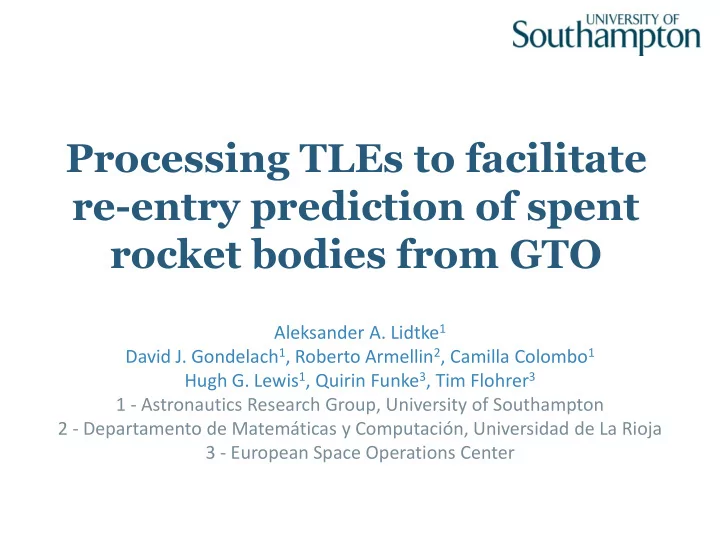

Processing TLEs to facilitate re-entry prediction of spent rocket bodies from GTO Aleksander A. Lidtke 1 David J. Gondelach 1 , Roberto Armellin 2 , Camilla Colombo 1 Hugh G. Lewis 1 , Quirin Funke 3 , Tim Flohrer 3 1 - Astronautics Research Group, University of Southampton 2 - Departamento de Matemáticas y Computación, Universidad de La Rioja 3 - European Space Operations Center
Re-entry prediction Knowledge Prediction of the of the MODEL present future Now Altitude Reality Prediction Time 6 th International Conference on Astrodynamics Tools and 16 Mar 2016 2 Techniques
How to improve TLE-based predictions 6 th International Conference on Astrodynamics Tools and 16 Mar 2016 3 Techniques
How to improve TLE-based predictions Today AAS 2016, Napa, CA 6 th International Conference on Astrodynamics Tools and 16 Mar 2016 4 Techniques
Problems with TLEs 6 th International Conference on Astrodynamics Tools and 16 Mar 2016 5 Techniques
Problems with TLEs 6 th International Conference on Astrodynamics Tools and 16 Mar 2016 6 Techniques
Problems - in life 6 th International Conference on Astrodynamics Tools and 16 Mar 2016 7 Techniques
Addressing problems (with TLEs) 1. Corrected TLEs 2. Time gaps 3. Outliers in mean motion and events that physically change the object 4. Outliers in eccentricity and B* – need to estimate the ballistic coefficient 5. Outliers in inclination – need orbit determination to converge 6 th International Conference on Astrodynamics Tools and 16 Mar 2016 8 Techniques
Corrections Before 2011 After 2011 6 th International Conference on Astrodynamics Tools and 16 Mar 2016 9 Techniques
Corrections Before 2011 After 2011 6 th International Conference on Astrodynamics Tools and 16 Mar 2016 10 Techniques
Time gaps 6 th International Conference on Astrodynamics Tools and 16 Mar 2016 11 Techniques
Mean motion outliers 6 th International Conference on Astrodynamics Tools and 16 Mar 2016 12 Techniques
Mean motion outliers 6 th International Conference on Astrodynamics Tools and 13 16 Mar 2016 Techniques
Events – change BC and SRPC 6 th International Conference on Astrodynamics Tools and 16 Mar 2016 14 Techniques
Mean motion filter tuning 6 th International Conference on Astrodynamics Tools and 16 Mar 2016 15 Techniques
Mean motion filter tuning 6 th International Conference on Astrodynamics Tools and 16 Mar 2016 16 Techniques
Outliers in n, e, i , and B* 6 th International Conference on Astrodynamics Tools and 16 Mar 2016 17 Techniques
Outliers in n 6 th International Conference on Astrodynamics Tools and 16 Mar 2016 18 Techniques
Outliers in e 6 th International Conference on Astrodynamics Tools and 16 Mar 2016 19 Techniques
Outliers in i 6 th International Conference on Astrodynamics Tools and 16 Mar 2016 20 Techniques
Outliers in B* 6 th International Conference on Astrodynamics Tools and 16 Mar 2016 21 Techniques
Re-entry prediction error Prediction epoch 𝜐 𝐵 Δ𝜐 Altitude 78 km Reality Prediction Time Δ𝜐 Relative error: 𝜀𝜐 = 𝜐 𝐵 6 th International Conference on Astrodynamics Tools and 16 Mar 2016 22 Techniques
Effects of filtering on prediction accuracy 6 th International Conference on Astrodynamics Tools and 16 Mar 2016 23 Techniques
Importance of filtering 6 th International Conference on Astrodynamics Tools and 16 Mar 2016 24 Techniques
Conclusions and recommendations • Filtering of the TLEs is key to get good predictions, however it isn’t always necessary • Filter in all orbital elements you’re using • Be wary that the TLEs change with time (2011, 2013…) • Outliers => robust statistics 6 th International Conference on Astrodynamics Tools and 16 Mar 2016 25 Techniques
Contact: Aleksander Lidtke Astronautics Research Group Faculty of Engineering and the Environment University of Southampton Southampton SO17 1BJ United Kingdom : al11g09@soton.ac.uk : www.aleksanderlidtke.com 6 th International Conference on Astrodynamics Tools and 16 Mar 2016 26 Techniques
Changes in TLE generation process 6 th International Conference on Astrodynamics Tools and 16 Mar 2016 27 Techniques
Why do we care Object count Fraction 30000 0.7 0.6 25000 Large objects – many R/Bs 0.5 Object fraction 20000 Object count 0.4 15000 0.3 10000 0.2 5000 0.1 0 0 1 10 100 500 1000 10000 More Mass bin (kg) 6 th International Conference on Astrodynamics Tools and 16 Mar 2016 28 Image credit: NASA Techniques
We don’t know the re -entry epoch too well 24 hours lead time. 6 th International Conference on Astrodynamics Tools and 16 Mar 2016 29 Techniques
We don’t know the re -entry epoch too well 48 hours lead time. 6 th International Conference on Astrodynamics Tools and 16 Mar 2016 30 Techniques
We don’t know the re -entry epoch too well 74 hours lead time. 6 th International Conference on Astrodynamics Tools and 16 Mar 2016 31 Techniques
When we filter too many TLEs 6 th International Conference on Astrodynamics Tools and 16 Mar 2016 32 Techniques
When we filter too many TLEs 6 th International Conference on Astrodynamics Tools and 16 Mar 2016 33 Techniques
When we DO NOT filter TLEs 6 th International Conference on Astrodynamics Tools and 16 Mar 2016 34 Techniques
Recommend
More recommend